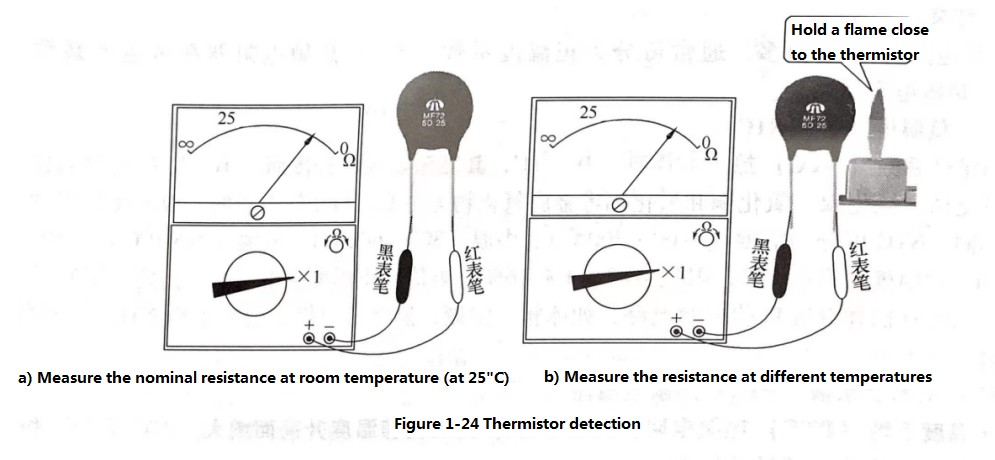Schritte zur Thermistorerkennung
Aug 05, 2024Die Thermistorerkennung ist normalerweise in zwei Schritte unterteilt. Nur wenn beide Schritte normal sind, kann der Thermistor normal sein. In diesen beiden Schritten kann auch die Art des Widerstands (NTC oder PTC) bestimmt werden, wie in der folgenden Abbildung dargestellt:

Der erste Schritt wird üblicherweise verwendet: Messen des Nennwiderstands bei Raumtemperatur (ca. 25 °C). Wählen Sie entsprechend dem Nennwiderstand den passenden Ohm-Bereich. Der Nennwiderstand des Thermistors in der Abbildung beträgt 5 Ω, der Bereich ist also RX1, und die roten und schwarzen Messleitungen berühren die beiden Elektroden des Thermistor bzw. wie in der Abbildung oben gezeigt, und überprüfen Sie dann den gemessenen Widerstandswert auf dem Zifferblatt.
Wenn der Widerstandswert mit dem Nennwiderstandswert übereinstimmt oder diesem nahekommt, bedeutet dies, dass der Thermistor normal ist.
Wenn der Widerstandswert 0 ist, bedeutet dies, dass der Thermistor kurzgeschlossen ist.
Wenn der Widerstandswert unendlich ist, bedeutet dies, dass der Thermistor offen ist.
Weicht der Widerstandswert zu stark vom Nennwiderstandswert ab, bedeutet dies, dass die Leistung des Thermistors nachgelassen hat oder beschädigt ist.
Der zweite Schritt kann das ändern Temperaturmessung Widerstandswert. Nähern Sie sich dem Thermistor mit einer Flamme (lassen Sie die Flamme nicht den Widerstand berühren, um ein Verbrennen des Widerstands zu vermeiden). Lassen Sie, wie in der Abbildung oben gezeigt, die Hitze der Flamme den Thermistor erhitzen und berühren Sie dann die roten und schwarzen Testleitungen zu den beiden Elektroden des Thermistors und überprüfen Sie dann den gemessenen Widerstand auf dem Zifferblatt!)
Wenn sich der Widerstandswert im Vergleich zum Nennwiderstandswert ändert, bedeutet dies, dass der Thermistor normal ist.
Wenn sich der Widerstandswert in Richtung größer als der Nennwiderstandswert ändert, bedeutet dies, dass es sich bei dem Thermistor um einen PTC-Widerstand handelt.
Wenn sich der Widerstandswert in Richtung weniger als den Nennwiderstandswert ändert, bedeutet dies, dass der Thermistor ein NTC-Widerstand ist.
Wenn sich der Widerstandswert nicht ändert, bedeutet dies, dass der Thermistor beschädigt ist.
Nanjing Shiheng Electronic Technology Co., Ltd. verwendet häufig die beiden oben genannten Methoden zur Erkennung von Thermistoren!
STICHWORTE :